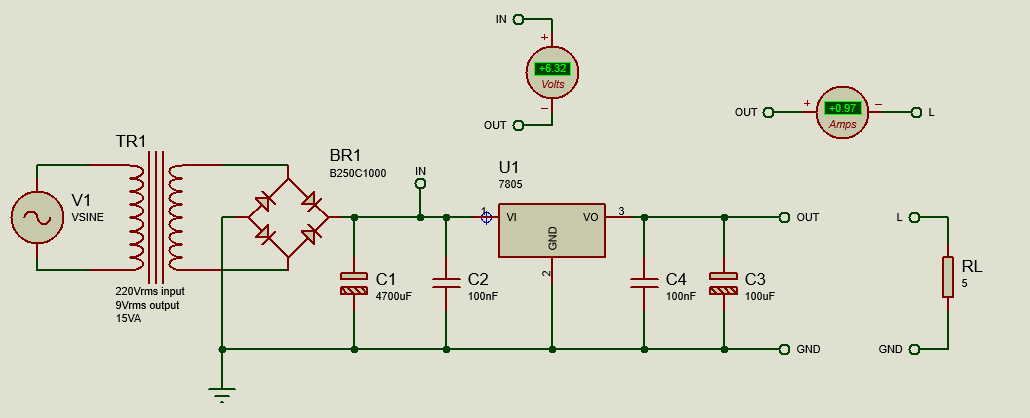
Multi Stage Amplifier Circuit Graph Results. A more correct gain and more accurate result would be described by: G Loaded = - h feR L/(h ie + (1+h fe)R 4 Real Time Simulationįor a bit of fun we can also run a real time simulation (via the play button) and we should see the same waveforms on the virtual scope and we would do using a real 4 channel oscilloscope. Moreover not all datasheets report hybrid parameters and, finally, we wanted to keep things as simple as possible. Such approximations are still acceptable as the main goal is not detailed analysis of a BJT common emitter configuration. This is because of the (very reasonable) approximation of the gain as: G Loaded = -RL/R4 As a slightly picky point of clarity it's noticeable that the simulated gain value is a little lower than the overall gain we predicted with our calculations. We can also see that the bandwidth at the -3dB point is 1.21MHz which also satisfies our initial specification. Analysing the frequency response then we note an overall gain of 49.4dB or: G Vout/Vin = 10 49.4dB/20 = 295 Graphs can be maximised via the right click context menu. After running both graphs the results should look like the following. We can do this in Proteus from the right click context menu over a graph. With a graph based simulation you run the simulation for a period of time and then analyse the results. The Multi Stage Amplifier Circuit.Ī demo copy of Proteus is required to open the.
#HOW TO OPEN PDSPRJ FILE IN PROTEUS 7 DOWNLOAD#
The circuit is basically a block copy of the single stage we've been working with but for convenience it's provided for download via the link below. Let's now look at our multi-stage amplifier and see well it conforms to expectations. The last stage loaded resistor is the parallel of R3 and 100kΩ resulting in 5.3kΩ The Multi Stage Amplifier The overall gain of a 4-stages amplifier, the which last stage is loaded by 100kΩimpedance, would be: Gain = A1 x A2 x A3 x A4 = 3.99 x 3.99 x 3.99 x 5.3 or 20 x log (336.6) = 50.3dB Now the loaded G will become: G Loaded = -R L/R4 = -3.99 or 20 x log(3.99) = 12.0dB We call R L the loaded collector resistance this will be the parallel of R3 and R i. Now we can compute the overall gain of each stage loaded by the previous one. Simulating the graph analysis and maximizing it we can find that input resistance is 13.9kΩ. This allows us to plot the result of a formula based on probes on the circuit, in this case making use of the voltage and current probes to plot resistance. The trick to getting the the input resistance plotted on the graph is to use what's called a trace expression.

We can arrange a schematic file like thisĪ demo copy of Proteus is required to open the. We can use DC Transfer Curve Analysis (available in Proteus and other SPICE tools) to help us to characterize the 2N3904 in order to find the working point in steady state condition. For our design we will use the 2N3904 in the linear region as an amplifier. The 2N3904 is an epitaxial planar NPN, general purpose transistor for small signals and switching application. We're going to use the popular 2N3904 NPN BJT. We will supply this amplifier with a 12Vdc power supply.

We need an amplifier with at total Gain greater than 46dB, (Gain > 200), and a frequency response from less than 10Hz up to 1MHz -3dB. In order to get the input impedance high enough we will set a collector current I C as low as possible 1mA will be sufficient General Specification This is the effect of the input impedance of the next stage against the gain of the previous one. However, the value of each stage gain must consider the loading effect.

The total gain is calculated as the product of each gain of any individual stage: Gain = A1 x A2 x A3 x A4 This approach is fine if, as in this case, we don’t require the DC amplifier response.
#HOW TO OPEN PDSPRJ FILE IN PROTEUS 7 SERIES#
In other words we are connecting each stage by using a capacitor in series between the output of the previous stage with the input of the next one. The amplifier we are going to design is a simple cascade connection where four identical stages are connected by RC coupling. There are several advantages with multistage amplifiers, notably achieving high gain with good frequency response and low level distortion. This article shows a design process for a simple four stage BJT Amplifier based on the popular silicon 2N3904 NPN transistor.


 0 kommentar(er)
0 kommentar(er)
